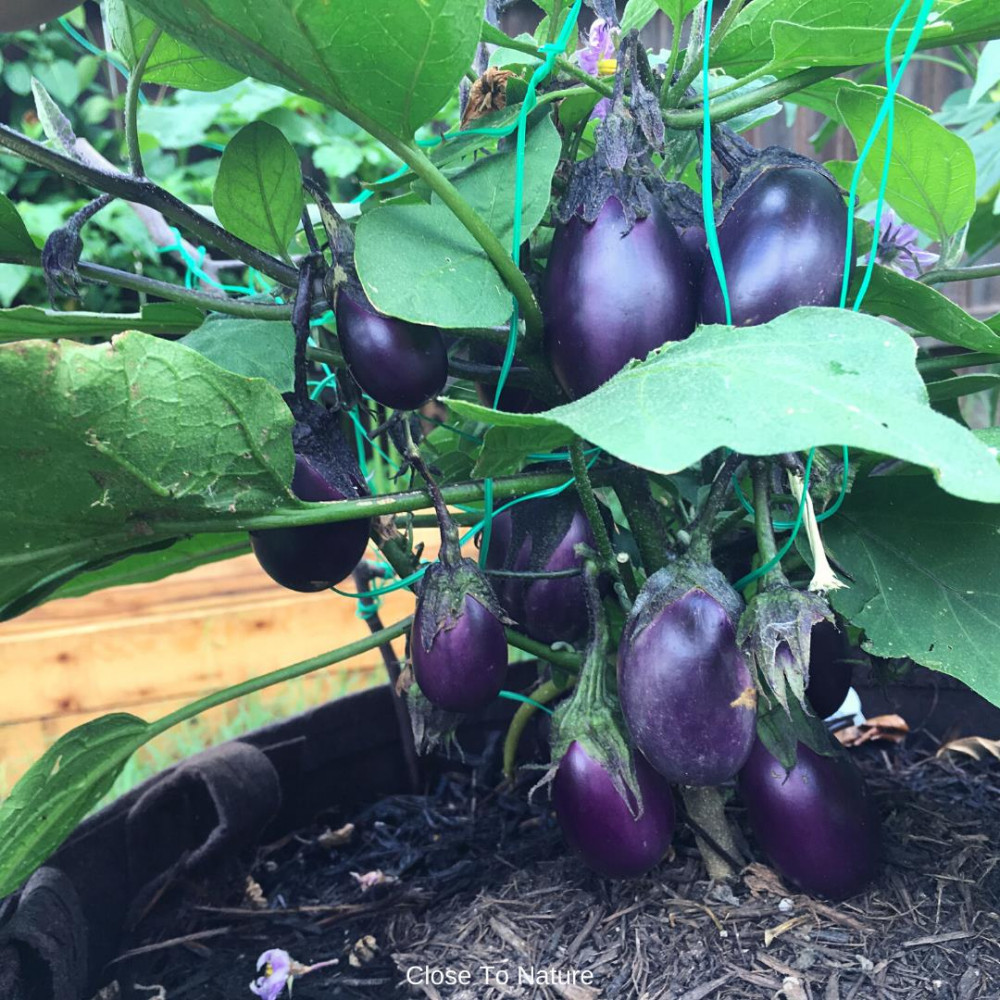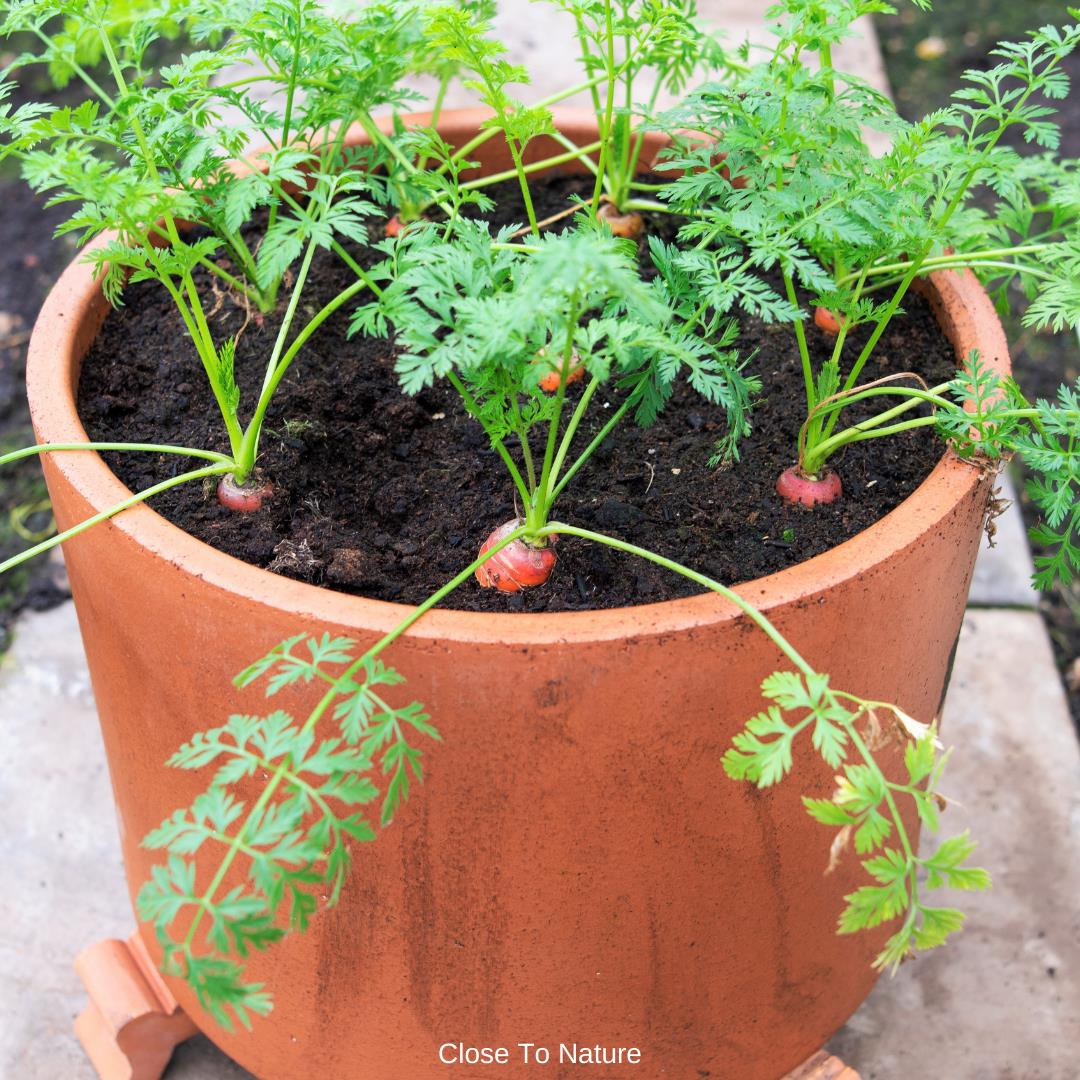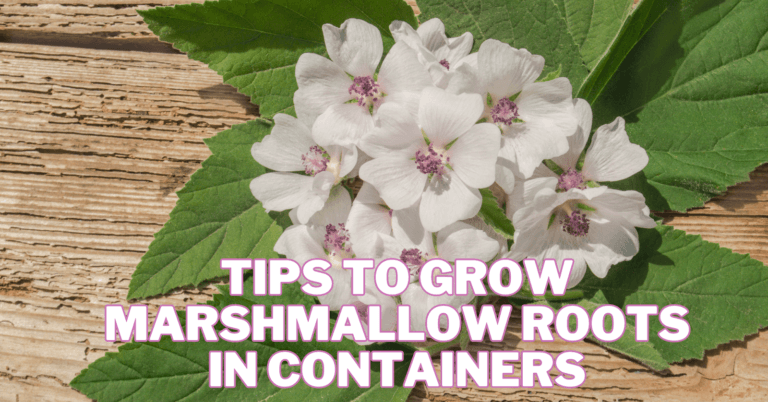Best Vegetables To Grow in A Container Garden
Best Vegetables To Grow In A Container Garden
No property space doesn't mean you cannot grow your dream garden. Container gardening has surged in popularity in the last decade as city dwellers have discovered the desire to raise their own food. Before we go into these vegetables, there are a few things to consider.
Almost every vegetable can be grown in a container. You may need a large pot, but as long as you have a place for the container, it's a possibility. So, if you want to grow something in a pot, you can do so.
You should be aware that some items will not produce as well in containers. You can yield less because the root system couldn't spread out as effectively as it could when planted in the ground.
Check out these 16 vegetables you can produce even if you don't have a garden plot but a sunny patio, porch, or balcony.

1. Tomatoes (Solanum lycopersicum)
Tomatoes are unquestionably one of the happiest potted veggies. Tomatoes are one of the most popular “vegetables” (although technically a fruit if you want to be picky) and a great potted plant to grow at home.
Tomatoes come in two varieties: indeterminate and determinate. Determinate kinds are great for containers because they aren't as huge, but they harvest all at once, so be ready to preserve all of the tomatoes quickly.
Indeterminate containers can be enormous, with some reaching up to 6 feet! Tomatoes require a lot of sunlight.
Therefore, a roof terrace or a sunny windowsill would be ideal. Keep in mind that they'll need to be watered frequently.
- USDA Growing Zones: This plant can be grown as an annual plant in any zone.
- Soil requirements are deep, moist, and well-drained.
- Sun Exposure: Full sun

2. Potatoes (Solanum tuberosum)
Freshly harvested potatoes have a completely different flavour from store-bought potatoes. They have higher water content and a harsh, earthy flavour to usher in the freshness of spring.
Growing potatoes in containers requires much soil and water, but the effort and time are well worth it.
Growing potatoes in pots takes a lot of soil and water, but it's worth it because fresh potatoes are tasty.
- USDA Plant Zones: 3 to 10
- Soil Requirements: Well-Draining, Nutrient-Rich
- Sun Exposure: Full Sunlight

3. Peppers (Capsicum annuum)
Peppers are another vegetable that may be grown in pots. Peppers are more productive when grown in containers, reducing cross-pollination between different species of peppers.
Both hot and sweet, Peppers may grow in pots and thrive in grow boxes. Some brightly coloured peppers would look great in your garden.
For optimal development, each pot should be at least 12 inches deep. The plants should be kept in pots that receive 6-8 hours of direct sunlight, although 8-10 hours is optimal.
Peppers require good drainage in their containers and should be watered regularly. Peppers dislike standing water or when the soil is too damp.
- USDA Plant Zones: Grown as annuals in all zones
- Soil Needs: Moist soil with good drainage
- Sun Exposure: Full sun

4. Eggplant (Solanum melongena)
Even though eggplants are prone to various garden pests, they are simple to grow. Eggplants are heat-loving plants that require high temperatures during the day and at night, making them an ideal summer crop. If you reside in a warm climate, you can grow it all year.
In addition, container gardening is easier to maintain than a huge vegetable garden. It is vital to keep the pots in direct sunlight and feed them frequently (like with all other tomato-related plants such as peppers, tomatoes, and potatoes; eggplants are also heavy feeders).
- USDA Growing Zones: 5 to 12
- Soil Needs: Good drainage, evenly moist soil
- Sun Exposure: Full sun

5. Onions (Allium cepa)
One of the easiest ways to eliminate spring fever is to plant onions and other alliums at the end of the winter.
Enjoying a continuous growing season in some sections of the country without worrying about freezing temperatures or frost is feasible.
There is no need to begin seeds indoors to escape the bitter winter cold in those places.
- USDA Growing Zones: 5 and 6
- Soil Needs: well-drained soil with pH between 6.0 and 7.0
- Sun Exposure: adequate sun, between four and six hours a day.

6. Peas (Pisum sativum)
Peas climb on a trellis or support structure, so you would not assume you can grow them in containers.
Growing peas in pots isn't difficult if you choose a dwarf or bushy kind. Furthermore, children enjoy growing peas; you could be amazed at how much your children enjoy fresh peas.
Peas can be planted in early spring and fall when the weather cools. English peas, snow peas, and sugar snap peas are the three types of peas.
They don't require a large pot. Having a wide pot is more important than having a deep one. All you'll need is a 6-8-inch-wide container.
- USDA Growing Zones: 2 to 11
- Soil Needs: Good drainage, enriched or loamy soil
- Sun Exposure: Full sun

7. Beets (Beta vulgaris)
You may be surprised to find a root crop on this list, but root crops thrive very well in pots since the soil can be kept airy rather than compressed. Beets are ideal for growing in compact places and are popular in container gardens.
The only thing to remember is that they require a very deep pot to develop freely. A container with a depth of 10 to 12 inches is excellent to ensure proper root growth. Keep your containers in direct sunshine, defined as 6 hours of direct sunlight every day.
Make sure the pH of the soil is between 6.0 and 7.5. You can raise the acidity of your soil by adding some wood ash.
- USDA Hardiness Zones: 2-11
- Soil Needs: Loamy, Acidic Soil
- Sun Exposure: Full Sunlight
Here are beet recipe ideas from my other website: 7 Delicious Beet Recipes For Your Kids

8. Lettuce And Salad Greens (Lactuca sativa)
Lettuce is perfect for growing in small, gloomy locations because of its thin root structure and easygoing disposition. You will have the opportunity to harvest leafy lettuce several times during the growing season.
Lettuce is a cool-season crop that can be planted several weeks before your area's last frost date.
Choose a planter at least six inches deep with a broad opening. This enables you to grow multiple lettuce plants.
Leaf lettuce can grow closer than head lettuce, usually 4 inches apart. Aside from selecting the appropriate container, use well-draining soil and water frequently.
Lettuce requires a lot of moist soil, and soil in containers dries out quicker than dirt in the ground.
- USDA Hardiness Zones: 2 to 10
- Soil Requirements: Sandy, Loamy, Well-Draining
- Sun Exposure: Full Sunlight to Partial Shade
Lettuce does not require nearly as much sunlight as other veggies. Johnny's Elegance Greens Mix and Hudson Valley Seed Library's Mesclun Mix are excellent salad greens and mesclun mixes for container gardens that taste wonderful and look beautiful in decorative pots.

9. Spinach (Spinacia oleracea)
Like leaf lettuce, spinach appears to be suited for life in a pot. Like many lettuce species, it grows nicely in partial shade and any type of location, including on your windowsill.
One of the best veggies to grow in pots is spinach. It thrives in partial shade and full sunlight and adapts well to various environments.
Because spinach has shallow roots, you don't need a particularly deep pot. However, it is recommended that you use one that is rather large so that it has enough room to expand out.
- USDA Hardiness Zones: 2 to 9
- Soil Needs: Well-Draining, Nutrient-Dense
- Sun Exposure: Full Sunlight to Partial Shade
Here are more recipe ideas from my vegan website: 7 Best Spinach Recipes For Your Kids

10. Cucumbers (Cucumis sativus)
Cucumbers are one of those vegetables that shout summer. Fresh cucumbers in salads are a favourite of many people.
Cucumbers are fast-growing vegetables that are frequently produced in pots. Cucumbers come in two varieties: bush and vining.
You can also grow a kind usually used for pickling or consumed. Both types are delicious in salads, but cucumber slices do not make good pickles.
- USDA Hardiness Zones: 4 to 11
- Soil Requirements: Loamy, Well-Draining
- Sun Exposure: Full Sunlight
In a container, either of these plants can thrive. Bush cucumbers are shorter and produce fewer cucumbers. Vining cucumbers require a trellis or tomato cage.
There are a few things you should know about cucumbers and container gardening. For starters, they're heavy feeders that require frequent watering.
Before planting, ensure the soil is not dry and that plenty of compost has been applied for nutrients.
You'll need a large pot with at least 5 gallons of capacity. They'll require a lot of room to develop, and you'll need room in the container to construct a support structure for the vines to climb up.

11. Kale (Brassica oleracea)
Are you looking for a vegetable that thrives in containers while simultaneously being nutrient-dense? Kale is an excellent choice.
Kale is a nutrient-dense vegetable. Blend it into smoothies, sauté mature leaves, or pluck young leaves for a fresh, tender salad addition. It's a versatile green high in nutrients and vitamins and can be used in various ways.
Kale grows quickly as well. With three to four plants, you can feed a family of four once a week. They're pretty prolific!
A family of four can get an excellent weekly yield from three or four plants. The most important thing to remember is that your pot should have a minimum diameter of 12 inches and use a well-draining potting mix.
- USDA Hardiness Zones: 4 to 10
- Soil Needs: Loamy, Moist, Well-Draining
- Sun Exposure: Full Sunlight to Partial Shade

12. Beans (Phaseolus vulgaris L)
Fresh green beans aren't impossible to come by. They're the ideal complement to any patio or balcony.
Growing beans in pots can be done in two ways. You can plant a “bushy” bean that will happily grow in a container without any additional support or a climbing bean that will climb up a trellis.
To begin, select the appropriate container. A pot with a minimum depth of 12 inches is required. Standing water is terrible for beans, so ensure the pot has enough drainage holes.
Then, you must pick whether you want a bush bean that does not require additional support or a pole bean that requires a trellis.
Pole beans are a fantastic choice if you want to maximize vertical space. Existing fences, support systems, and walls can be grown up. Pole beans, on the other hand, require longer to harvest.
Bush beans are smaller plants that grow 18-24 inches tall and yield in 60 days or less. You might be able to have two bean crops, depending on your growing zone!
- USDA Hardiness Zones: 2 to 10
- Soil Needs: Well-Draining, Sandy, Loamy Soil
- Sun Exposure: Full Sunlight

13. Chard (Beta vulgaris, variety cicla)
Greens are a terrific choice for container gardening, as anyone who enjoys it can attest. To begin with, there's chard.
This underappreciated plant has lovely leaves and (sometimes) bright bouquets and grows well in containers.
Chard is an underappreciated plant, which is unfortunate because it comes in a rainbow of hues. It would be a shame not to add as much chard as possible in a beautiful garden.
Rainbow chard is a fantastic kind to grow. It comes in various colours, including red, white, pink, and yellow stems. It could be ready to harvest in 50-60 days.
Consider using a pot with a depth of at least 8 inches; many gardeners prefer lengthy containers that house numerous chard crops. It's even easier to take some for salad now.
- USDA Hardiness Zones: 3 to 10
- Sun Exposure: Full Sunlight to Partial Shade
- Soil Needs: Slightly Acidic, Well-Draining Soil

14. Carrots (Daucus carota, subspecies sativus)
Do you want to try growing carrots in a container? Carrots are another root crop that thrives in containers and is a cool-weather crop that may be planted 2-3 weeks before your area's last frost date.
You are more likely to grow a healthier plant if you actively water the container. If you want your plants to grow longer, consider deeper containers.
Like other root crops, carrots require a pot at least eight inches deep. You're looking for roots here! Instead of compacting the soil, keep it as airy as possible.
- USDA Hardiness Zones: 3 to 10
- Sun Exposure: Full Sunlight
- Soil Requirements: Loose, Loamy, Sandy, Well-Draining

15. Radishes (Raphanus)
Another root crop that does nicely in containers is radishes. Gardeners typically overlook radishes, yet they may thrive in even the tiniest pot.
To grow radishes as a potted plant, scatter some seeds in the container and give them a healthy, regular watering.
Nonetheless, they are one of the fastest-growing vegetables. They're also perfect for children's gardens because they can be harvested in as little as 30 days. Because they are root crops, you'll want to ensure the soil is lovely and fluffy.
Radishes need containers at least six inches deep, but larger types require eight to ten inches deep pots. Three inches of space is necessary for each radish.
- USDA Hardiness Zones: 2 to 10
- Sun Exposure: Full Sunlight to Partial Shade
- Soil Needs: Well-Draining, Sandy Soil
Tips: Watering before plant stress is an important container gardening strategy. When watering, fill each container three or four times before moving on to the next, allowing at least 20% of the water supplied to the top of the pot to drain out the bottom.

16. Cauliflower (Brassica oleracea var. botrytis)
Cauliflower is a cool-season vegetable that can be grown successfully in a container garden, although it does require a deeper container than some other vegetables.
The container should be at least 12 inches deep to accommodate the long roots of the cauliflower plant.
When choosing a cauliflower variety for container gardening, look for compact or dwarf varieties that don't require as much space.
Some good options include ‘Snow Crown,' ‘All Year Round,' and ‘Graffiti.' These varieties are also known for their excellent flavour and texture.
Cauliflower plants require well-draining soil and at least six hours of sunlight daily. They also need consistent moisture, so water your plants regularly, especially during dry spells.
Providing adequate support is one potential challenge when growing cauliflower in a container garden.
As the plants grow, they can become top-heavy and may need to be staked or supported with a tomato cage or other structure.
This will help prevent the plants from tipping over or breaking under the weight of the cauliflower heads.
Harvesting cauliflower from a container garden is similar to harvesting from a traditional garden.
When the heads are fully formed and have a tight, compact appearance, they are ready to be harvested. Use a sharp knife to cut the heads off the plant, leaving about 1 inch of stem attached.
Here are cauliflower recipes from my vegan website: Best Vegan Cauliflower Steak Recipes.

Conclusion
By putting vegetation around your home, you may help remove carbon dioxide from the atmosphere and safeguard the natural environment.
Growing plants in containers, even if you only have a tiny outside space, is simple, gives colour and interest, and contributes a modest amount to air purification.
I trust you enjoyed this article about the Best Vegetables To Grow In A Container Garden. Please stay tuned for more blog posts to come shortly.
JeannetteZ
>>>Please click here to read my all-inclusive article, About The Essential Companion Planting Guide<<<
>>>Please click here to read my all-inclusive article about Container Gardening<<<
>>>Are you interested in homegrown herbs and medicine? Please click here to find out more about it!<<<
Your Opinion Is Important To Me
Do you have thoughts, ideas, or questions? I would love to hear from you. Please leave me your questions, experience, and remarks about this article on the Best Vegetables To Grow In A Container Garden in the comments section below. You can also email me at Jeannette@Close-To-Nature.org.
Disclosure
This post may contain affiliate links. I earn from qualifying purchases as an Amazon Associate and other affiliate programs. Please read my full affiliate disclosure.
You might also enjoy these blog posts:
All About Wild Turkeys – A Large Shy Bird
Interesting Facts About Woodpeckers
Healthy Natural Dog Food – Grant Your Dog A Longer Life
Why Is My Dog Stressed And How To Relieve It?








